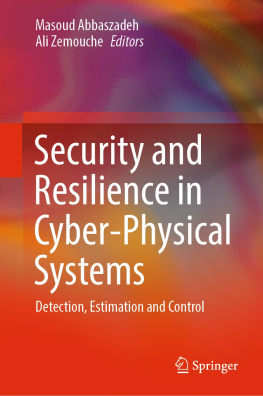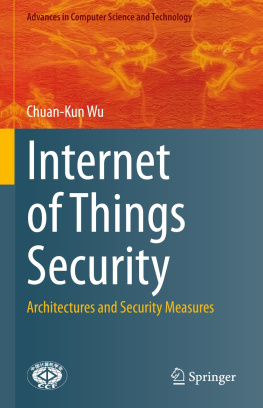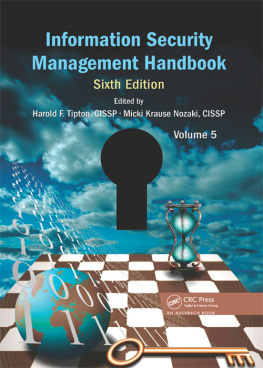Physical Security:
150 Things You Should Know Second Edition
Lawrence J. Fennelly,
CPOI, CSSI, CHL-III, CSSP-1
Marianna A. Perry,
M.S., CPP, CSSP-1
AMSTERDAM BOSTON HEIDELBERG LONDON
NEW YORK OXFORD PARIS SAN DIEGO
SAN FRANCISCO SINGAPORE SYDNEY TOKYO
 Butterworth-Heinemann is an imprint of Elsevier
Butterworth-Heinemann is an imprint of Elsevier 
Butterworth-Heinemann is an imprint of Elsevier
The Boulevard, Langford Lane, Kidlington, Oxford OX5 1GB, United Kingdom 50 Hampshire Street, 5th Floor, Cambridge, MA 02139, United States
Copyright 2017, 2000 Elsevier Inc. All rights reserved.
No part of this publication may be reproduced or transmitted in any form or by any means, electronic or mechanical, including photocopying, recording, or any information storage and retrieval system, without permission in writing from the publisher. Details on how to seek permission, further information about the Publishers permissions policies and our arrangements with organizations such as the Copyright Clearance Center and the Copyright Licensing Agency, can be found at our website: www.elsevier.com/permissions . This book and the individual contributions contained in it are protected under copyright by the Publisher (other than as may be noted herein).
Notices
Knowledge and best practice in this feld are constantly changing. As new research and experience broaden our understanding, changes in research methods, professional practices, or medical treatment may become necessary.
Practitioners and researchers must always rely on their own experience and knowledge in evaluating and using any information, methods, compounds, or experiments described herein. In using such information or methods they should be mindful of their own safety and the safety of others, including parties for whom they have a professional responsibility. To the fullest extent of the law, neither the Publisher nor the authors, contributors, or editors, assume any liability for any injury and/or damage to persons or property as a matter of products liability, negligence or otherwise, or from any use or operation of any methods, products, instructions, or ideas contained in the material herein.
Library of Congress Cataloging-in-Publication Data
A catalog record for this book is available from the Library of Congress
British Library Cataloguing-in-Publication Data
A catalogue record for this book is available from the British Library
ISBN: 978-0-12-809487-7
Publisher: Candice Janco
Acquisition Editor: Sara Scott
Editorial Project Manager: Hilary Carr
Production Project Manager: Punithavathy Govindaradjane
Designer: Matthew Limbert
Cover Image Credit: Karen Camilovic with Camilovic Creative
Typeset by TNQ Books and Journals
The Industry has become aware of Cyber-security challenges, but few have a plan. Many will be unprepared for IT and Cyber requirements from end users. Education is the key.
Fredrik Nilsson, 2016
My wife, Annmarie and I wish to dedicate this book to our lovely daughter, Alison-Margaret Boyce, graduate of Holy Cross and mother of two outstanding college students, sister to three brothers and married to Charles E. Boyce, Esq.
Larry Fennelly
I dedicate this book to Larry Fennelly, a wonderful friend, writing partner and mentor. Thank you.
Marianna Perry.
In Memoriam
Louis A. Tyska, CPP, Past President of ASIS, Lou, and I wrote this as well as several other books for our profession. We were not just partners but best friends; his writing was pure and he saw things not as they were but how they should be. Foreword
The title Physical Security: 150 Things You Should Know is truly a catchall title that includes a multitude of topics not common in other books? Active shooter/active assailant incidents, stabbings, and random unthinkable acts of violence are present in our workplaces and at our educational campuses weekly. We cannot escape these mindless crimes and thefts that impact every segment of the security management operation. Security matters more now than ever. Trying to decide which security con- cepts are right for your organization is a daunting full time task. However, I would suggest you start off with an assessment professionally done, so that you can identify your complexs needs.
This book is your road map to decoding and developing an effective security strategy beginning with the design build phase and addressing everything in between including life safety issues. Larry Fennelly and Marianna Perry have the knowledge and experience to see these complicated and ever-changing security challenges from a unique and multifaceted viewpoint. They both share their insight with the reader, and therefore every security practitioner needs to read this book. Most security books focus on one topic, i.e., risk analysis or security surveillance systems (CCTV) and access control. I love this text because it has so much material in it that we need to address our everyday problems.
Todays security books are more and more complicated and technical. We as practitioners must stay ahead of the curve, to keep up. Thomas Norman, CPP; David Paterson, CPP; Sandi Davis (Woman in Security); James Broder, CPP; Michael Fagel PhD; and Dr. Jennifer Hestermann, these practioners are our future educators along with Larry Fennelly and Marianna Perry. Writing a book title 150 Things . etc. was not an easy task. I commend these authors and those who I mentioned for their vision and dedication will keep us ahead of the curve.
Linda Watson, MA, CPP, CSC, CHS-V
Whirlaway Group LLC
Property Management
WHAT IS PHYSICAL SECURITY?
There are different opinions and interpretations about exactly what physical security is, but the two defnitions below incorporate all the aspects and are all-inclusive.
The American Society for Industrial Security (ASIS) International (2005) defnes physical security as follows:
Physical security focuses on the protection of people, property, and facilities through the use of security forces, security systems, and security procedures. Physical secu-rity personnel oversee proprietary or contract uniformed security operations, iden-tify security system requirements, assess internal and external threats to assets, and
develop policies, plans, procedures, and physical safeguards to counter those threats. Physical security can include the use of barriers, alarms, locks, access control sys-tems, protective lighting, CCTV, and other state-of-the-art security technology. The Army Field Manual, No. 319.30 defnes physical security as that part of
security concerned with physical measures designed to safeguard personnel; to pre-vent unauthorized access to equipment, installations, material, and documents; and to safeguard against espionage, sabotage, damage, and theft.
EFFECTIVE PHYSICAL SECURITY
Someone has to question design, development, and event planning decisions. Do you think that anyone from the police department or fre department for that matter asked the builder of a major hotel in Kansas City whether they had extra steel reinforcing rods left over when they built the cross-bridge that fell and resulted in many deaths and injuries? Did anyone ask the planners how the downtown pedestrian malls would respond when the Flash Mob fad swept the country in early 200016? No! Major planning mistakes were made then and continue to be made because no one is asking the right questions . People : Will always be the number one aspect in security. Their motivation and








 Butterworth-Heinemann is an imprint of Elsevier
Butterworth-Heinemann is an imprint of Elsevier 

